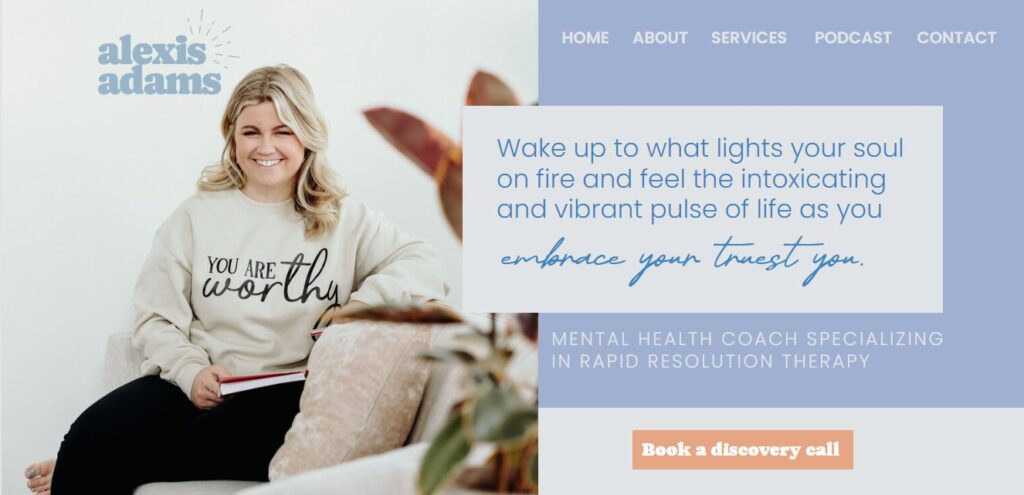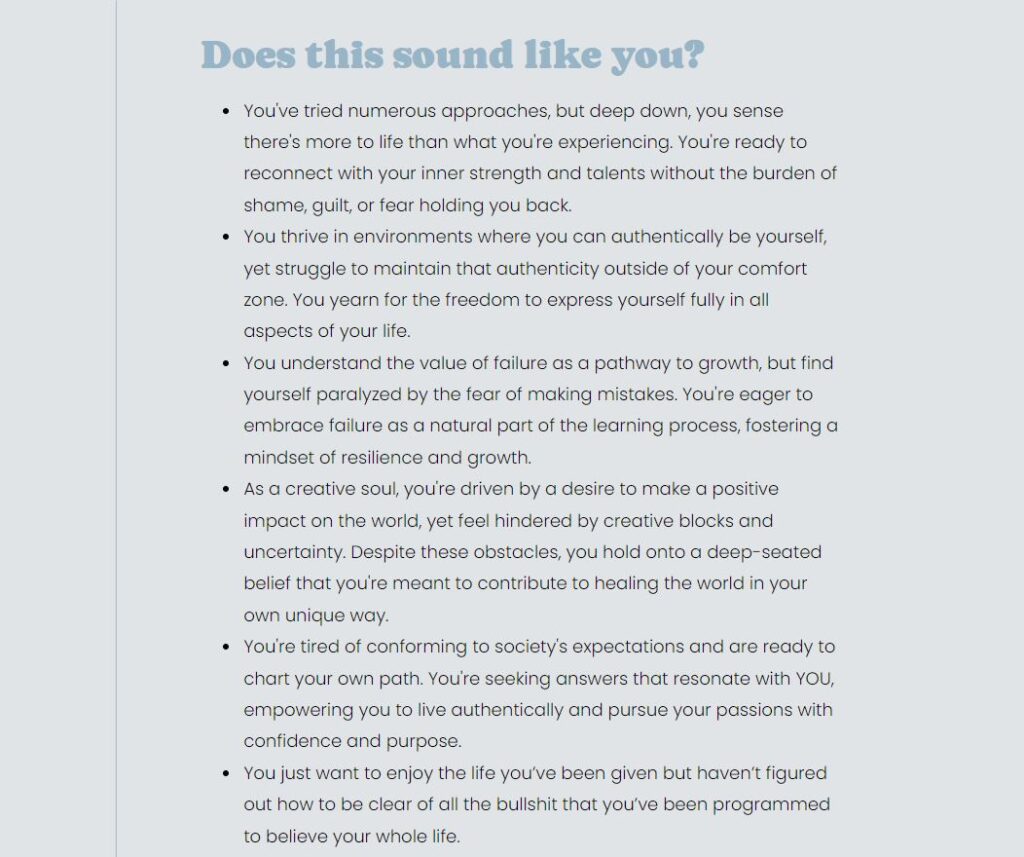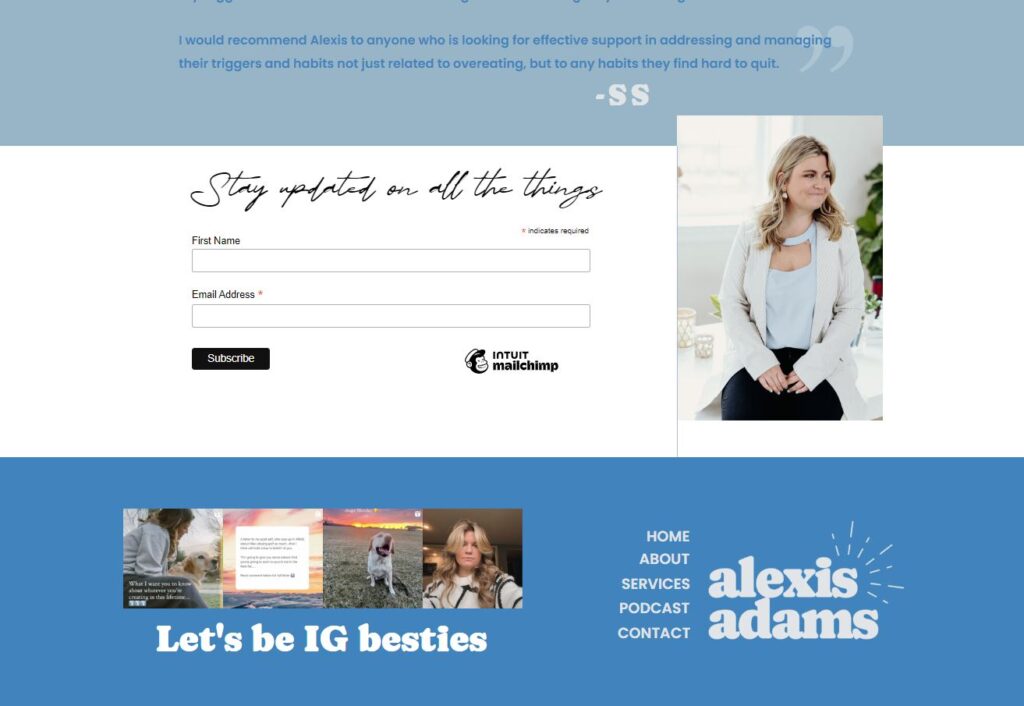When it comes to using your website to grow your business, one of the biggest things you have to take into account is the customer journey. Oftentimes, I find that this is a missing piece of the puzzle in so many business owners’ websites. But without it, you are basically telling your website visitors, “hey, here’s my page, figure it out.”
Honestly? That’s a great way to get people to click away from your website.
People want direction. People want clarity. People need their hand held. And with a clear customer journey, you’re not just hoping that your website visitors will get the value that they need to make the decision to invest in you…you are actually guiding them to that decision.
With a clear customer journey, you will see a lot of great things happening on your website…
- Increased conversions – more people will buy because you have given them all the pieces of the puzzle – the information, the trust, the vibes – to want to take action with you
- Better user experience – you will see your website visitors staying on your page longer because your website is engaging, clear and it makes them want more
- Better quality leads – not only will you see more leads coming through, but you’ll see BETTER leads coming through when you have a clear customer journey, because you’re able to speak directly to your ideal client, their struggles and their desires
So today, let’s dig into what you can do to make sure you have a clear customer journey set up for your website so that you can warm up those website visitors the minute they land on your page. Let’s get into it!
Understanding the customer journey
So let’s start by talking about what the customer journey actually is. In a nutshell, the customer journey is the process that a potential client goes through from the moment they become aware of your business to the point where they make a purchase and beyond. I like to break it down into phases:
- Awareness
- Consideration
- Decision
- Retention
Let’s dig into each phase a little more and we’ll start with the Awareness Phase. This is the phase where potential clients first learn about your business. They might find you through search engines, social media, or word of mouth. It’s important during this stage to communicate your value and to attract attention.
So for your website, this Awareness Phase is when people first come to your website from either Google or a social media post or a friend that shared your info. You want to be sure that the very first thing that your website visitors see explains your value and grabs their attention. This is usually done with the hero section of your homepage where you can communicate exactly who you are and what you do. This is why your hero section is SO important – website visitors will click away if they don’t think that you will have something of value to offer them.
So make sure for this Awareness Phase that you are clearly and concisely communicating what it is you do and the problem that you solve or the product you sell.
Here’s an example from one of my clients, Alexis. For her home page, we designed this hero section that boldly states what she does and who she helps:

Right away, Alexis explains the type of transformation she will help you experience and also what it is that she does and what she specializes in. A clear hero section is super duper important for the Awareness Phase of the customer journey – this is the point where people maybe are walking down the street, they come across your store (aka your website), they take a peek inside through the window and think to themselves “Hmmm, will I like anything in here?” It’s at that moment that they decide whether to walk through that door or not.
THIS IS YOUR HERO SECTION.
It is the gateway for someone to come into your world, so make sure this is clear, designed well, it’s bold and you’re stating who you help as well as what you do.
The next phase of the customer journey is the Consideration Phase. This is where your website visitors will start to evaluate your products or services. They are wondering if what you have to offer is worth it, if it will help them reach their goals and if it’s the right choice for them.
I use the hero section to draw people in who are in that Awareness Phase, and then I warm them up in the next sections of the website as they go through this Consideration Phase by addressing a few things:
- Empathize with their struggles: this is where I will show the potential client that I understand where they are coming with, I will typically call out the struggles they are currently experiencing and call out what they are feeling right now
- Talk about where they want to be: this is where I will lay out the vision of what they are trying to achieve. I will talk about the goals they are currently trying to achieve that I know I can help them with
- Build trust and credibility: a huge part of warming up those cold website visitors is to build trust – you can do this by adding in testimonials that show you are legit, you can solve people’s problems and you can get them from point A to point B
I will touch on all of these points on the home page or on the services/sales pages for my clients’ offers. It’s so important to remember during the Consideration Phase that your website visitors really need to build that trust and see that you can help them get from where they are now to where they want to be, so paint that picture for them in your website copy.
After the Consideration Phase comes The Decision Phase. This is where potential clients decide to make a purchase or take a desired action. Here is where it’s important to make sure your website has clear calls-to-action all throughout every page of your website, it needs clean, simple navigation so that it’s easy for them to take action as well as a streamlined checkout process so that when they know they are ready to buy, they are headed straight to the cart where they can whip out that credit card and hit BUY NOW.
During this stage, you also want to be sure you have clearly laid out the features and benefits of your offer so that you can take a website visitor from considering your offer to deciding to purchase because they can clearly see what’s in it for them.
Some tips for this:
- Instead of just listing out every single aspect of your offer, make sure you are tying everything back to how it will help them. So instead of saying they will get a 60 minute coaching call, say “a 60 minute focus session where we will map out your offer suite for the next 6 months so you know exactly what you’re selling and have total clarity on your game plan through the end of the year”. See how that resonates SO much better?
- Tie it back to emotions – people buy based off of their emotions, so relate every aspect of your offer back to how it will make your potential client feel. An example would be “Offer Planning PDF so you can stop feeling overwhelmed and feel confident knowing exactly what you’re promoting and when”
- Make your calls-to-action frequent, simple and straight forward. Use direct language that relates to what they want to achieve. “LET’S DO THIS”, or “GRAB YOUR SPOT NOW” are good examples.
Here’s an example of this from Alexis’ website. When sharing information about her 1:1 Transformational Sessions, she makes sure to relate back to her potential client’s emotions, what they want to experience and the shift they will make when they work with her.

Finally, the last stage of the customer journey is the Retention Phase. This is where you can focus on maintaining and nurturing client relationships post-purchase. Some good ways to do this are with resources like a blog, podcast or email newsletter where you can keep the value coming for your website visitors and clients. Having opt-in forms or free resources for them to download are a great way to help nurture this relationship with both potential and current clients.
The importance of understanding your ideal client and audience
In order for your customer journey to be effective, you really need to be crystal clear on who your ideal client is. Make sure you go deep AF with this – just naming off some demographics like she’s a service provider in her 30s-40s isn’t going to cut it. Get as detailed as you possibly can – what does she like to do? What are her desires and goals in life? What is she struggling with right now? What are her values? What is the most important to her? Think about those deep questions because the more specific you can be, then the more targeted your messaging can be on your website so that when your ideal client finds you, she feels like you are talking DIRECTLY TO HER.
My client Alexis did an amazing job of this on her website copy. We had a section where she calls out exactly what her ideal client is feeling and struggling with right now. When that exact person reads this on her website, they will not hesitate to want to work with her because they can feel confident knowing that she can help them. Here’s an example below:

Her copy is hella focused at a very specific person. And yeah, that might mean that some people may decide that she’s not for her. And that’s okay. Because wouldn’t you rather work with clients that really jive with you, your mission and what you have to offer? That is how you start to call better, more aligned clients into your business.
Mapping out each phase of the customer journey on your website
Now that you know what each phase of the journey is, let’s dig in a little more into how you can use your website to intentionally guide people through the journey.
AWARENESS PHASE:
- This is where you attract people to your website and draw them in so they want to keep scrolling
- You’ll utilize social media, SEO and content marketing to get people to your website so they can learn who you are
- This is also why it’s important to make sure your website is optimized for SEO – you have lots of relevant keywords in your website content as well as your meta descriptions and headings so that people are finding your website when they are searching online
CONSIDERATION PHASE:
- Make sure you are presenting your products and services effectively – have good, vibrant descriptions that relate to their emotions and their desired outcomes, have sales pages for each of your signature offers so you can really dig in and show them the value of your offer and how you can take them from where they are to where they want to be
- Utilize testimonials throughout your website to build trust and credibility – Even better is to have case studies or a portfolio if you’re a service provider so you can really paint the picture for potential clients on where your past clients were previously, what you helped them with and the results they were able to achieve. Ending with a testimonials
DECISION PHASE:
- Make it easy for someone to take the next step and buy from you by having calls-to-action throughout every page of your website
- Have a smooth checkout process where it’s simple and easy for people to click, fill in their information and hit BUY. You don’t want to create any roadblocks for them so ensure that when people click on those call-to-action buttons, it takes them straight to the checkout that is easy to fill out
RETENTION PHASE:
- Continue to build the relationship by utilizing content on your website such as a blog, podcast as well as a free resources page where they can not only gain more valuable information from you but also get on your email list
- Have several ways for people to continue to connect with you on your website – list out your social on your footer and contact page, have an announcement bar where they can download a free resource or schedule a free call, add in a freebie download section on your home page, have a free resources page with all of the free things you have in one place so you can keep adding value while building up that email list
Here’s a great example of giving your website visitors multiple ways to connect with you long past when they leave your website – Alexis has an email list opt in form at the bottom of all of her website pages along with her footer which has her Instagram feed so that people can get to know her on a deeper level.

Let’s pull it all together
Ultimately, having a clear and intentional customer journey on your website is the best way to ensure that website visitors aren’t just landing on your page and having a free-for-all. When you have a clear customer journey, you are able to guide them and warm them up from being a brand new stranger just coming into your world to an absolute raving fan who is obsessed with you and can’t wait to work with you.
Your customer journey is one of the best ways to make sure that your website is strategic and intentional. And when you do that, you will see more clients, more leads and more money rolling in. WE LIKE DAT.
Planning out an intentional customer journey is something that I do with all of my clients in my Website in a Week offer. Not only will we develop your branding and get clear AF on the vibes and branding for your business, but we will make sure your website has intention and strategy so that its not just existing on the internet – it’s actually intentionally guiding website visitors through a journey where they know that YOU are the one for them.
If you’re ready to get started with Website in a Week, head over to my website and let’s get it started! I also offer free website audits if you have a website and want some new eyes on it to give you the insight and feedback to improve your website’s user experience and see what changes you can make to bring in more aligned clients and sales into your business!
Share in the comments below – do you have your customer journey mapped out for your website? If not, what are the first steps you plan to take to make sure you get this implemented into your website strategy?

View comments
+ Leave a comment